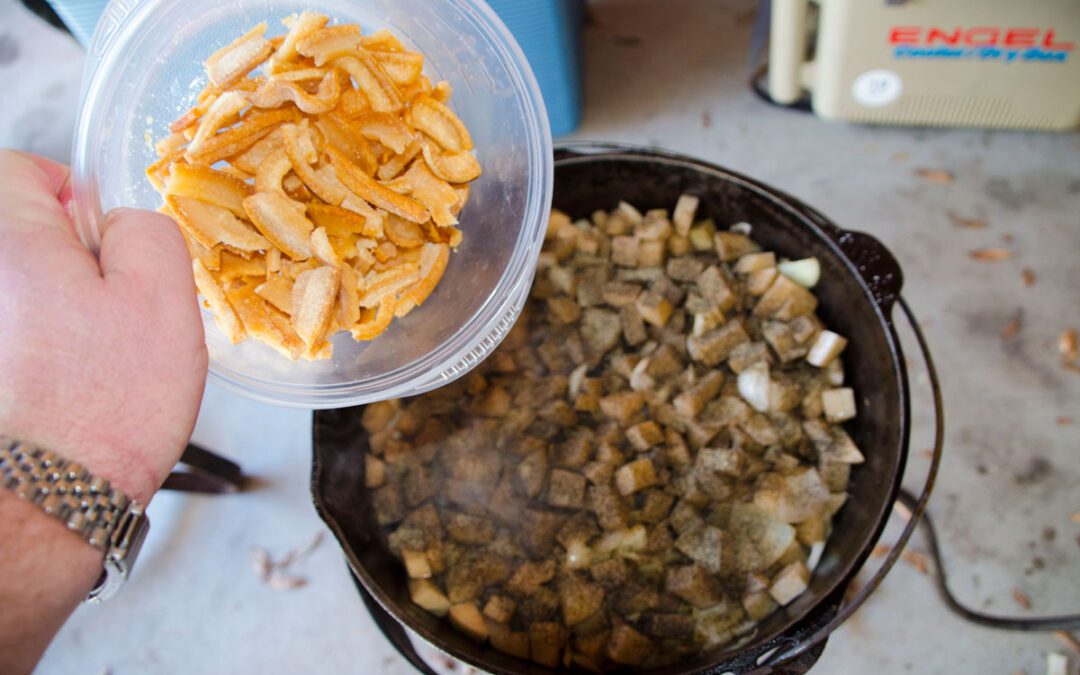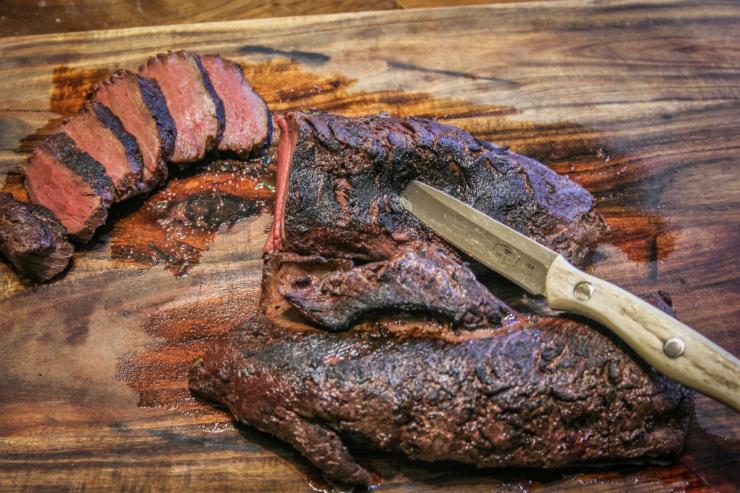There are a million ways to create the culinary concoction known as catfish stew, and almost as many ingredient variations.
If one were to Google the origins of catfish stew, the first thing you will likely see is an image of the American flag. Hell yeah, born in the USA and proud of it! And while the journalism professors have warned us not to trust Wikipedia as an always-reliable source (but why would they lie about something as serious as catfish?), old Wiki will shoot you straight and tell you that catfish stew is a dish commonly found in the Southern United States, particularly in good old South Carolina. God Bless America, and Pat Conroy, too!
But if you were born Southern and raised right, then you didn’t need the Internet to tell you any of that. You probably had an Uncle Rudy who hung out at fish camps, told off-color jokes, smoked Marlboro Reds and drank Budweiser even on Sunday, and while he never told anyone the secret ingredient to his stew the whole family knew it was ice cold Bud and a little Hunts ketchup that he added when he thought no one was looking.
Food historians and chefs know that catfish stew was inspired by both Native American traditions and African food ways, adapted with European ingredients. Stewed catfish dishes are widely found across western Africa, particularly in Nigeria, and likely inspired similar stews that have found their way into American bowls from the Savannah River to the Mississippi, where they keep a 100-pound catfish or two laying around. Catfish stew is such an important part of American food history that, if you searched the Internet thoroughly enough, you can find a version of the same recipe served to George Washington at Mount Vernon. Catfish stew really bloomed in popularity in the 1930s, when Southern restaurants advertised their “famous catfish stews” to draw daily customers and attract folks for social functions and meetings. It was a filling meal and a cheap one, which was crucial during those Depression days.
Today, there are still eateries below the Mason Dixon known primarily for their unique version of this Southern classic. Catfish stew is so popular in the Palmetto State that Rock’s Pond Campground on South Carolina’s Lake Marion hosted a well-attended Catfish Stew Cook-off for years, and the small town of Elgin, S.C., celebrates a Catfish Stomp every December since 1976, featuring a parade, a carnival and hundreds of gallons of stew.
Catfish stew is such a standby with outdoorsmen and home cooks that when South Carolina Wildlife magazine asked for recipes back in the 1980s, they were bombarded with so many stew recipes that the editors devoted an entire chapter to catfish stew in their Southeastern Wildlife Cookbook.
I don’t think catfish stew is a passing fad.
The Battle of Little Big Stew
Like barbecue hash – another South Carolina-born creation – or Tex-Mex chili, there are a million ways to create the culinary concoction known as catfish stew, and almost as many ingredient variations. Catfish lovers will fiercely guard their secret recipes, and even more fiercely defend their favorite style of stew. Your basic and most popular version features a simple but magical mixture of crushed tomatoes, potatoes, onions, fatback or bacon and catfish, simmered down in a pot. However, catfish stew can be anything but basic. It is a humble yet complex dish.
Some versions call for catfish that is boiled or stewed down, others demand it baked or even fried. Some cooks like it thick and chunky; others stew it down until it resembles the consistency of barbecue hash. Some folks deviate widely from the norm and add carrots, corn, bell peppers, eggs or other miscellaneous items found around the fish camp. It has even been reported by credible witnesses that some home cooks use cream of mushroom soup as a thickening agent or – it pains me to say this – spaghetti sauce. Even with the basic version, everyone and his uncle has a unique recipe, and the truth is there is almost no wrong way to make a catfish stew – but don’t say that too loudly at most fish camps.
There are three basic styles: a relatively thin tomato-based classic that is most popular, a thicker, hearty milk-based stew that chowder lovers would enjoy, and even a layered dish baked in a Dutch oven that originated in the Savannah River valley.
Which is the best? Try them all and decide for yourself with your favorite hot sauce and crackers on the side. Or, do like Uncle Rudy’s nephew here and combine your favorite styles. You can’t go wrong. Unless you use spaghetti sauce – and then you and I can’t be friends anymore.
Savannah River-Style Catfish Stew
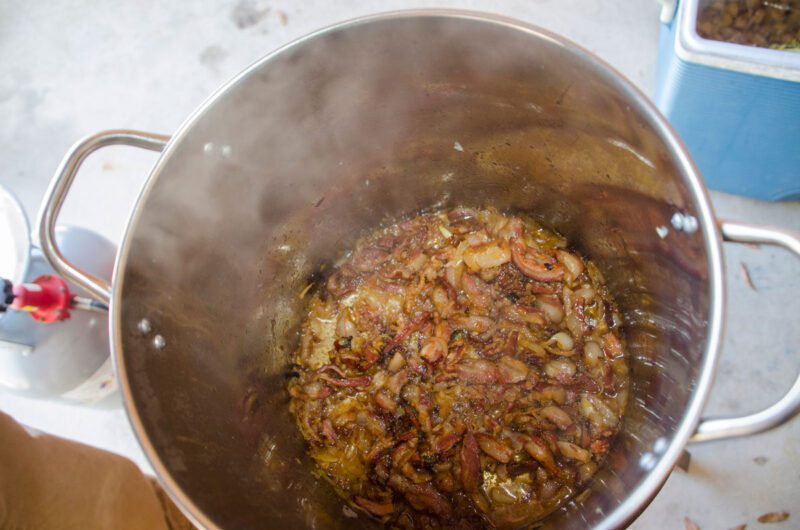 The Savannah River is home to a catfish or two, and folks in South Carolina and Georgia enjoy catching them with heavy rods, trot lines, set lines tied to branches and even sturdy bamboo cane poles. But catching them is only half the fun – try eating them right on the riverbank!
The Savannah River is home to a catfish or two, and folks in South Carolina and Georgia enjoy catching them with heavy rods, trot lines, set lines tied to branches and even sturdy bamboo cane poles. But catching them is only half the fun – try eating them right on the riverbank!
This recipe is said to have originated along the Savannah River, although history doesn’t tell us which side. My theory is that it was those zany Georgia boys, who prefer Brunswick Stew to Carolina Hash, but I don’t want to start a border dispute so let’s move on. This recipe is usually cooked in a Dutch oven, either over a campfire or gas, but can be cooked indoors if you insist.
Ingredients:
- 3-4 lbs. of catfish nuggets or fillets cut into 2-3 inch squares
- ½ pound fatback (jowl bacon will work)
- 4 medium to large onions, peeled and sliced ¼ inch
- 6 large potatoes, peeled and sliced ¼ inch
- Fresh hot peppers or dried cayenne pepper to taste
- Salt and black pepper to taste
In a large Dutch oven, preferably cast iron, cover the bottom with a layer of fatback or bacon. Next, add a layer of onions, then a layer of potatoes, a layer of peppers (optional) and finally a layer of freshly rinsed catfish. Sprinkle seasoning a little at a time as you go. Repeat until you use all ingredients or the pot is full. Do not add water because the fish and veggies have enough moisture.
Place the Dutch oven over the campfire with hot coals on top of the lid and cook for at least six hours. (Makes a perfect overnight breakfast while you are fishing.) Or, cook on the lowest setting on your stove or oven for 3-4 hours. Do not open the lid or stir until you are ready to serve.
Malcolm Lucas’s White Catfish Stew
David Lucas, former editor of South Carolina Wildlife, shared his Dad’s chowder-style catfish stew recipe. The secret to this one is that the catfish is fried beforehand to give it a little chew.
Ingredients:
- Fried catfish
- Diced potatoes and onions in proportion to the amount of fish (Basically 1:1 fish to onions and 1:2 fish to potatoes. Five pounds of dressed fish, 3 to 4 pounds of Vidalia onions and 7 to 8 pounds of white potatoes is a good starting point for a fairly large pot and will feed a crowd of 25 or so. Extra is good because, as with most chowders, it’s even better reheated the next day.)
- 6 boiled eggs
- Fresh ground black pepper
- 1/2 gallon whole milk
- Fatback, bacon, cured ham chips or other pork meat flavoring
Fry catfish as you would normally to eat by themselves. Any breading that has cornmeal will work. You don’t need to fry the fish “well done” because it will cook further in the stew.
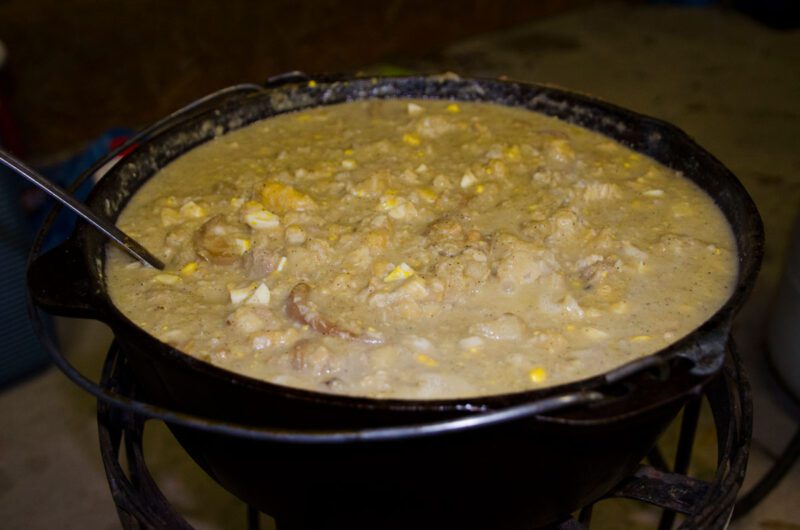 Peel and dice potatoes and onions. Cover with water to a depth of about 1 inch in large pot and simmer. Add salt and generous amount of black pepper. This should simmer for several hours until potatoes have begun to break up and onion has totally disappeared. In the meantime, fry bacon or other meat and hard boil, peel and dice eggs. Add meat to pot as soon as meat is done.
Peel and dice potatoes and onions. Cover with water to a depth of about 1 inch in large pot and simmer. Add salt and generous amount of black pepper. This should simmer for several hours until potatoes have begun to break up and onion has totally disappeared. In the meantime, fry bacon or other meat and hard boil, peel and dice eggs. Add meat to pot as soon as meat is done.
When chowder/meat base appears almost as done as you would like it to be, add the fried catfish and the eggs. Slowly simmer until catfish is well incorporated and starting to come apart. The cornmeal from the fish should thicken the chowder considerably. Let it come to a slow boil, but don’t overcook. Adjust the spices at this point, adding more pepper as needed.
To finish the stew and give it a nice texture, turn the heat to dead low and slowly fold in some of the milk, adding a little bit at a time so it does not curdle or thin the chowder out too much. What you’re shooting for is a nice thick chowder with kind of a grainy texture and the fish well distributed throughout, the potatoes well broken up and only the larger chunks still together.
Serve with light bread, hush puppies, extra pepper and hot sauce.
Uncle Rudy’s Classic Red Stew
Ingredients:
- 2-3 lbs. of catfish, deboned
- 1 pound bacon
- 3-4 medium onions, peeled and sliced
- 4-5 large potatoes, peeled and cut into roughly one-inch cubes
- Large can of tomato juice or V-8 juice
- Two cans of crushed or petite diced tomatoes
- Worchestire sauce to taste
- Salt and pepper to taste
- Hot sauce to taste
- A splash of beer (optional)
- 2-3 bay leaves (optional)
In a medium-large stock pot, place cubed potatoes into a pot of water with salt and butter to boil. When done, remove from heat. Pour off a little of the water, but retain at least half of it. In a second pot, place catfish fillets, nuggets or whole catfish in a roasting pan with water, a little onion, salt and pepper to taste (I sometimes throw in just a pinch of Cajun or crab boil seasoning, and maybe a squeeze of lemon). Bring to a slow boil on medium heat until fish is tender and flaking. Remove the fish (debone if needed) and save at least a quart of the fish stock.
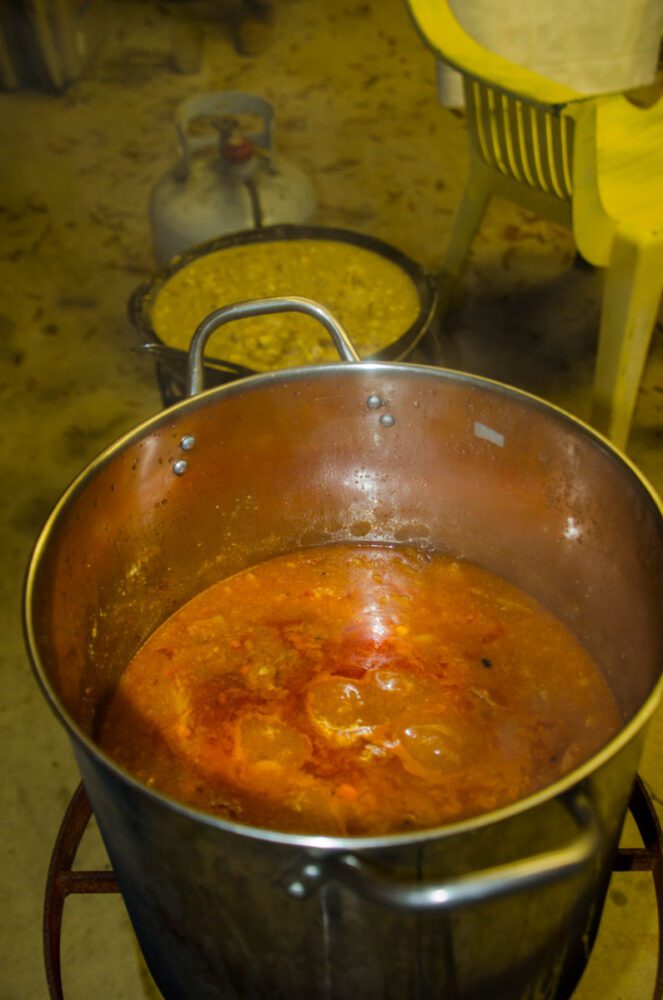 Cut bacon into small pieces and cook until crispy or mostly crispy in a sauté pan. Remove bacon, then sauté the onions until tender in the bacon grease. To the pot of cooked potatoes, add the fish, fish stock, tomatoes, onions and bacon. Bring to a simmer, adding the remaining ingredients to taste. Use as little or as much of the fish stock as you like for flavor, and add tomato juice or V-8 until the color is the perfect pinkish-red. For balance, you may have to tweak these two a little to get the color and thickness that suits your taste just right.
Cut bacon into small pieces and cook until crispy or mostly crispy in a sauté pan. Remove bacon, then sauté the onions until tender in the bacon grease. To the pot of cooked potatoes, add the fish, fish stock, tomatoes, onions and bacon. Bring to a simmer, adding the remaining ingredients to taste. Use as little or as much of the fish stock as you like for flavor, and add tomato juice or V-8 until the color is the perfect pinkish-red. For balance, you may have to tweak these two a little to get the color and thickness that suits your taste just right.
Serve with oyster crackers or hush puppies and hot sauce.
To deviate from Uncle Rudy’s recipe just slightly, I will sometimes add a cup or two of Bloody Mary mix for added flavor, and a cup of good seafood cocktail sauce for flavor and thickening. And to steal a page from the Lucas family cookbook, instead of hush puppies I’ll drop a few pieces of fried catfish in the bowl right before serving, and then lock the kitchen door and enjoy.
Don’t forget to say Grace.
 Eat Like a Wildman is a collection of the top rated wild game and fish recipes that Sports Afield magazine has published over the last 110 years. Lifelong food critic and cookbook author, Rebecca Gray selects and infuses a wonderful-tasting standards with her own culinary wizardry and provides instruction on the best methods for preparing fish and wild game to cook. Buy Now
Eat Like a Wildman is a collection of the top rated wild game and fish recipes that Sports Afield magazine has published over the last 110 years. Lifelong food critic and cookbook author, Rebecca Gray selects and infuses a wonderful-tasting standards with her own culinary wizardry and provides instruction on the best methods for preparing fish and wild game to cook. Buy Now

